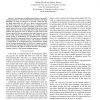Free Online Productivity Tools
i2Speak
i2Symbol
i2OCR
iTex2Img
iWeb2Print
iWeb2Shot
i2Type
iPdf2Split
iPdf2Merge
i2Bopomofo
i2Arabic
i2Style
i2Image
i2PDF
iLatex2Rtf
Sci2ools
91
Voted
ICRA
2007
IEEE
2007
IEEE
Learning and Evaluation of the Approach Vector for Automatic Grasp Generation and Planning
— In this paper, we address the problem of automatic grasp generation for robotic hands where experience and shape primitives are used in synergy so to provide a basis not only for grasp generation but also for a grasp evaluation process when the exact pose of the object is not available. One of the main challenges in automatic grasping is the choice of the object approach vector, which is dependent both on the object shape and pose as well as the grasp type. Using the proposed method, the approach vector is chosen not only based on the sensory input but also on experience that some approach vectors will provide useful tactile information that finally results in stable grasps. A methodology for developing and evaluating grasp controllers is presented where the focus lies on obtaining stable grasps under imperfect vision. The method is used in a teleoperation or a Programming by Demonstration setting where a human demonstrates to a robot how to grasp an object. The system first reco...
Related Content
| Added | 03 Jun 2010 |
| Updated | 03 Jun 2010 |
| Type | Conference |
| Year | 2007 |
| Where | ICRA |
| Authors | Staffan Ekvall, Danica Kragic |
Comments (0)

